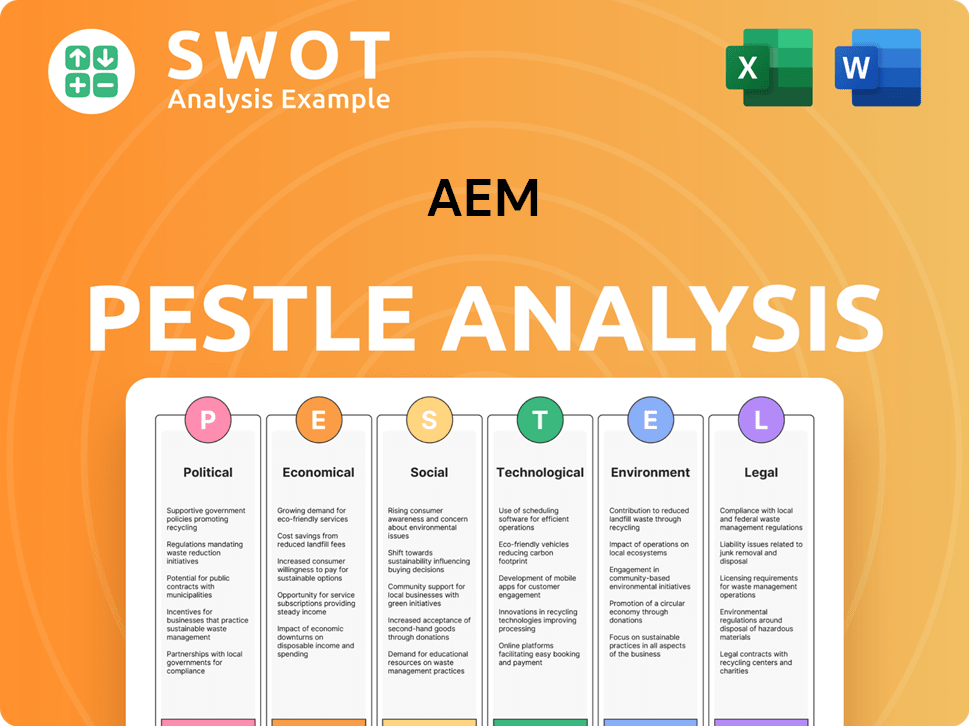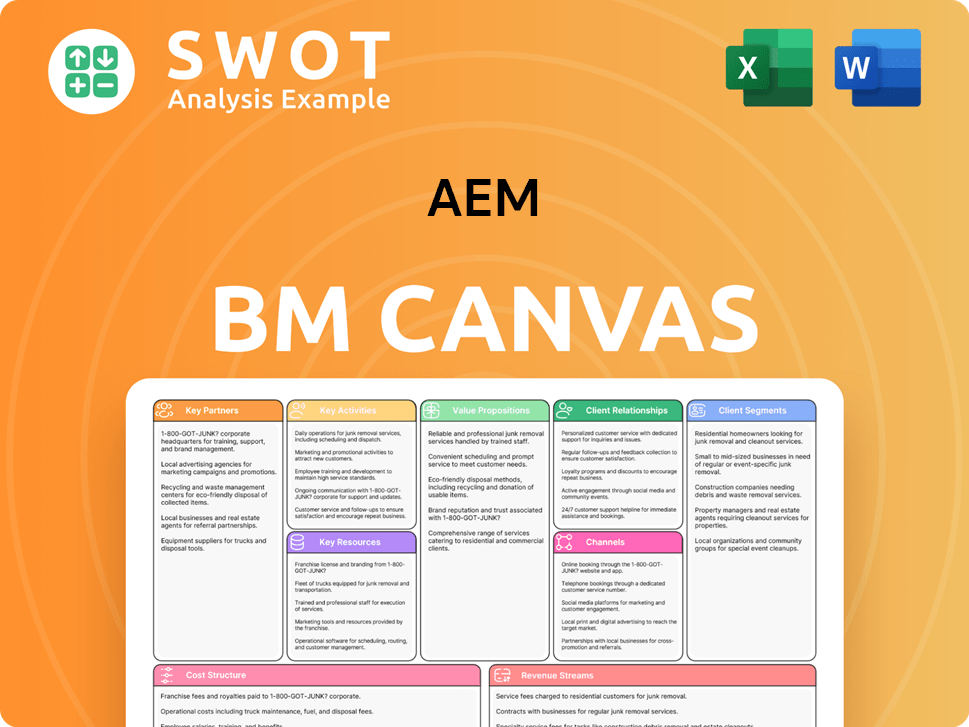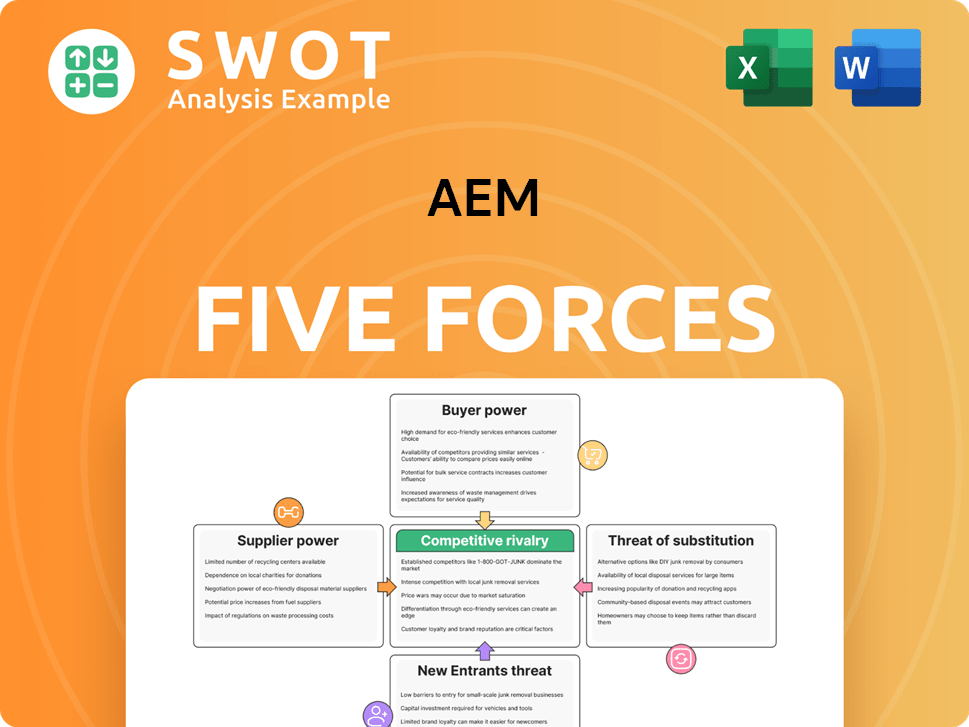AEM Bundle
Who Really Owns AEM?
Understanding a company's ownership structure is crucial for investors and strategists alike, revealing insights into its strategic direction and potential for growth. The story of AEM Holdings Ltd., for example, is a compelling case study in how ownership shifts can dramatically reshape a company's trajectory. From its beginnings to its current status as a global leader, the evolution of AEM's ownership offers valuable lessons for anyone navigating the complexities of the market.

This exploration of AEM SWOT Analysis will uncover the key players behind AEM company ownership, tracing its history from its founders to the present day. We'll examine the influence of institutional investors, and the impact of past acquisitions on the company's strategic focus. Discovering who owns AEM will provide a deeper understanding of its operations and future prospects, offering valuable insights for informed decision-making.
Who Founded AEM?
The story of AEM Holdings Ltd. begins with its predecessor, AEM-Evertech Holdings Ltd., which was listed on the Singapore Exchange (SGX) on December 19, 2000. Understanding the Growth Strategy of AEM requires a look back at its ownership structure and the individuals who shaped the company's early years.
At the time of the initial public offering, the founders held significant stakes in the company. This early ownership structure played a crucial role in the company's direction and development. The initial ownership provides insights into the company's origins and evolution.
The major shareholders at the outset were the founders themselves, Tok Kian You and Ang Seng Thor. Tok Kian You held a 12.5% stake, while Ang Seng Thor owned 11.2%. A key early investor was Transpac Capital Pte Ltd, a direct investment management company, which held a 25.9% stake in the company.
During its early stages, AEM-Evertech was involved in several business segments. These included:
- Design, development, and manufacturing of equipment for semiconductor assembly, testing, and finishing processes.
- Precision engineering products.
- Chemicals and services for surface finishing of semiconductors and connectors.
- Distribution of engineering materials.
Both Tok Kian You and Ang Seng Thor are no longer involved with AEM. By December 16, 2016, Tok Kian You's stake had decreased to 1.04%, which meant he was no longer considered a substantial shareholder. This shift indicates a change in the company's ownership and leadership over time.
AEM SWOT Analysis
- Complete SWOT Breakdown
- Fully Customizable
- Editable in Excel & Word
- Professional Formatting
- Investor-Ready Format

How Has AEM’s Ownership Changed Over Time?
The evolution of AEM's ownership structure has seen significant shifts over the years. Initially known as AEM-Evertech Holdings Ltd., the company officially rebranded to AEM Holdings Limited in 2007. A pivotal moment occurred in 2011 when Novo Tellus, a private equity firm, acquired a substantial stake through its Novo Tellus PE Fund 1, L.P. This followed Transpac Capital's divestiture, with Orion Phoenix, associated with Novo Tellus, initially holding 16.59% on November 23, 2011, later increasing to 28.1% by December 28, 2016.
This Competitors Landscape of AEM highlights the dynamic nature of the company's ownership. The acquisition by Novo Tellus marked a strategic change, influencing the company's direction and financial strategies. The subsequent involvement of institutional investors and the eventual emergence of Temasek as a major shareholder further shaped the ownership landscape.
| Date | Event | Impact |
|---|---|---|
| 2007 | Name change to AEM Holdings Limited | Reflected a strategic shift in the company's identity. |
| 2011 | Novo Tellus acquisition | Private equity firm Novo Tellus acquired a major stake. |
| August 31, 2021 | Temasek's investment | Temasek became the largest shareholder following a private placement. |
As of May 13, 2025, AEM Holdings Ltd. (SGX:AWX) has a diverse shareholder base. Institutional investors hold a significant portion, with mutual funds and ETFs owning approximately 14.03% (43.94 million shares). Other institutional investors hold around 29.81% (93.37 million shares), while public companies and retail investors collectively possess 56.15% (175.87 million shares). Temasek, a wholly-owned subsidiary, holds a substantial stake, solidifying its position as a key stakeholder. As of March 14, 2024, Temasek increased its deemed interest to above the 11.0% threshold.
The ownership of AEM has evolved significantly, with private equity firms and institutional investors playing crucial roles. Temasek's investment has solidified its position as a major shareholder.
- Novo Tellus acquired a major stake in 2011.
- Temasek became the largest shareholder in August 2021.
- Institutional investors and retail investors hold significant portions of the company.
- As of May 2025, mutual funds and ETFs hold approximately 14.03% of AEM.
AEM PESTLE Analysis
- Covers All 6 PESTLE Categories
- No Research Needed – Save Hours of Work
- Built by Experts, Trusted by Consultants
- Instant Download, Ready to Use
- 100% Editable, Fully Customizable

Who Sits on AEM’s Board?
The current board of directors of AEM Holdings Ltd. includes Wai San Loke as the Non-Executive Chairman. He also serves as a co-founder and Managing Director of Novo Tellus Capital Partners, which highlights a direct connection between a significant shareholder and the board's leadership. Other key members include Kin-Wah Loh (Non-Executive & Independent Director), Min Yew Tham (Non-Executive & Non-Independent Director), Ban Leng Toh (Lead Independent Non-Executive Director), Yean Hung Chok (Non-Independent Non-Executive Director), Yen Ning Chou (Independent Non-Executive Director), Andre Andonian (Independent Non-Executive Director), and Yee Chia Yeo (Independent Non-Executive Director). The board's composition suggests a blend of experience and independence, with an average tenure ranging from approximately 4.9 to 5.8 years, providing stability and institutional knowledge.
Min Yew Tham's role further connects the company to substantial shareholders, as he also represents Venezio Investments Pte. Ltd., a subsidiary of Temasek Holdings (Private) Limited. This connection underscores the influence of major institutional investors within the AEM company ownership structure. The presence of independent directors, alongside those with ties to significant shareholders, helps to balance interests and ensure robust corporate governance practices. This structure is typical for publicly listed companies aiming to maintain transparency and accountability.
| Board Member | Role | Affiliation |
|---|---|---|
| Wai San Loke | Non-Executive Chairman | Novo Tellus Capital Partners |
| Kin-Wah Loh | Non-Executive & Independent Director | N/A |
| Min Yew Tham | Non-Executive & Non-Independent Director | Venezio Investments Pte. Ltd. (Temasek Holdings) |
| Ban Leng Toh | Lead Independent Non-Executive Director | N/A |
| Yean Hung Chok | Non-Independent Non-Executive Director | N/A |
| Yen Ning Chou | Independent Non-Executive Director | N/A |
| Andre Andonian | Independent Non-Executive Director | N/A |
| Yee Chia Yeo | Independent Non-Executive Director | N/A |
AEM Holdings operates under a standard 'one-share-one-vote' structure, common among publicly listed companies on the Singapore Exchange. At the 2024 Annual General Meeting, shareholders approved the renewal of the Share Purchase Mandate, allowing AEM to buy back up to 10% of its issued shares (excluding treasury shares and subsidiary holdings). This mechanism is a strategic tool, especially useful for managing employee share schemes and potential acquisitions. There have been no recent reports of significant proxy battles or activist investor campaigns that have changed the company's decision-making process. For more information on the company's background, consider reading the Brief History of AEM.
The board includes members with ties to major shareholders, ensuring alignment of interests.
- The company uses a standard voting structure.
- Share buyback programs are in place to manage share capital.
- The board structure supports effective corporate governance.
- No recent proxy battles have influenced decision-making.
AEM Business Model Canvas
- Complete 9-Block Business Model Canvas
- Effortlessly Communicate Your Business Strategy
- Investor-Ready BMC Format
- 100% Editable and Customizable
- Clear and Structured Layout

What Recent Changes Have Shaped AEM’s Ownership Landscape?
Over the past few years, AEM Holdings has seen shifts in its ownership structure. The company's 6-Month Share Buyback Ratio was -0.20% as of December 2024, and the 3-Year Share Buyback Ratio was 0.00%, which indicates a lack of significant share repurchases during this period. However, the company maintained the flexibility to buy back up to 10% of its shares, a mandate that was up for renewal at the April 2024 AGM.
Leadership changes have also occurred. Ms. Chunyi Yin Leong (Amy) became CEO on July 1, 2024, and Kwek You-Cheer was appointed as the new Chief Financial Officer on January 2, 2025. Temasek increased its stake, becoming the largest shareholder in August 2021 and further increasing its deemed interest above 11.0% by March 14, 2024. The company continues to focus on its core competency in semiconductor and electronics test solutions, with a market capitalization of S$482.1 million as of June 2025.
The semiconductor sector has seen increased institutional ownership. AEM Holdings has been working to broaden its shareholder base, attracting more long-only institutional and family funds. This is seen as a positive step toward greater scrutiny and management accountability. The company is actively pursuing investor relations efforts to attract more institutional investors. Furthermore, AEM has been involved in acquisitions, such as CEI in July 2021, which resulted in the issuance of new shares. To learn more about the company's business model, you can read Revenue Streams & Business Model of AEM.
The ownership structure of AEM Holdings has evolved, with Temasek being a significant shareholder. Recent financial data shows a focus on attracting more institutional investors. The company has also been involved in acquisitions, impacting its share structure.
Ms. Chunyi Yin Leong (Amy) became CEO in July 2024. Kwek You-Cheer was appointed as CFO in January 2025. These leadership changes signal a shift in the company's strategic direction and management team.
As of December 2024, the 6-Month Share Buyback Ratio was -0.20%, and the 3-Year Share Buyback Ratio was 0.00%. The company’s market capitalization was S$482.1 million as of June 2025.
The semiconductor sector is seeing increased institutional ownership. AEM continues to focus on its core business in semiconductor and electronics test solutions. The company is actively pursuing investor relations efforts.
AEM Porter's Five Forces Analysis
- Covers All 5 Competitive Forces in Detail
- Structured for Consultants, Students, and Founders
- 100% Editable in Microsoft Word & Excel
- Instant Digital Download – Use Immediately
- Compatible with Mac & PC – Fully Unlocked

Related Blogs
- What are Mission Vision & Core Values of AEM Company?
- What is Competitive Landscape of AEM Company?
- What is Growth Strategy and Future Prospects of AEM Company?
- How Does AEM Company Work?
- What is Sales and Marketing Strategy of AEM Company?
- What is Brief History of AEM Company?
- What is Customer Demographics and Target Market of AEM Company?
Disclaimer
All information, articles, and product details provided on this website are for general informational and educational purposes only. We do not claim any ownership over, nor do we intend to infringe upon, any trademarks, copyrights, logos, brand names, or other intellectual property mentioned or depicted on this site. Such intellectual property remains the property of its respective owners, and any references here are made solely for identification or informational purposes, without implying any affiliation, endorsement, or partnership.
We make no representations or warranties, express or implied, regarding the accuracy, completeness, or suitability of any content or products presented. Nothing on this website should be construed as legal, tax, investment, financial, medical, or other professional advice. In addition, no part of this site—including articles or product references—constitutes a solicitation, recommendation, endorsement, advertisement, or offer to buy or sell any securities, franchises, or other financial instruments, particularly in jurisdictions where such activity would be unlawful.
All content is of a general nature and may not address the specific circumstances of any individual or entity. It is not a substitute for professional advice or services. Any actions you take based on the information provided here are strictly at your own risk. You accept full responsibility for any decisions or outcomes arising from your use of this website and agree to release us from any liability in connection with your use of, or reliance upon, the content or products found herein.